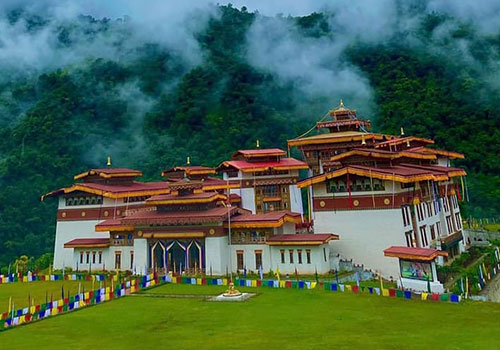Mailing List
Sign up for our mailing list to get latest updates and offers.
The tourists’ destinations in the country have predominantly centered around the western and central regions, while the eastern region holds significant potential for tourism development. PemaGatshel Dzongkhag, prioritizing sustainable Community Based Tourism (CBT), stands out due to its inherent strengths and close proximity to the Indian sub-continent. Despite initial discussions on CBT development in 2013, the region's potential remains largely untapped. Identified CBT products from 2013 now serve as pivotal elements for sustainable tourism in the Dzongkhag, promising to elevate the economic status of rural communities, particularly focusing on youth and women, while also preserving religious and cultural heritage.
PemaGatshel, known as the "Blissful Land of Lotus," earned its name from His Holiness the Dudjom Rinpoche's blessing in 1969. The circular ridges around the valley resemble the petals of a lotus flower, with the magnificent fortress of Durk Migyur Dechen Dzong symbolizing the inner bloom. The Dzongkhag boasts numerous cultural and religious heritage sites, alongside breathtaking natural landscapes and diverse flora and fauna, all integral to CBT experiences. Notable sites include Shalikhar Dzong (in ruins), Yongla Goenpa, Jashar Goenpa, Dungkhar Goenpa, Khawar Goenpa, and others, accessible via the Lotus Valley trail, offering visitors a panoramic view of the Druk Migyur Dechen Dzong at Denchhi.
The Dzongkhag also celebrates its rich local products, including Tshatshi Buram (sugarcane jaggery), Thongsa Kamthangma (cotton products), Tsharzo (cane products), Yurung Bura(textiles), Dung and Jaling, alongside unique culinary delights, folklore, traditional crafts, and performing arts.
Ultimately, the tourist destinations aims to benefit local businesses and rural communities by bolstering economic activity in both urban centers and rural areas. Anticipated developments include the construction of tourist accommodations, resorts, and recreational facilities, fostering employment opportunities in hotel management, tourism, culinary arts, and information technology services.
Furthermore, the tourist destination is expected to mitigate rural-to-urban migration patterns. In terms of gender equality, individuals of all genders have opportunities to showcase their skills in handicrafts and weaving. Ultimately, the Dzongkhag anticipates positive changes in happiness, satisfaction, environmental conservation, heritage preservation, and overall development, projecting a positive image to the wider world.
